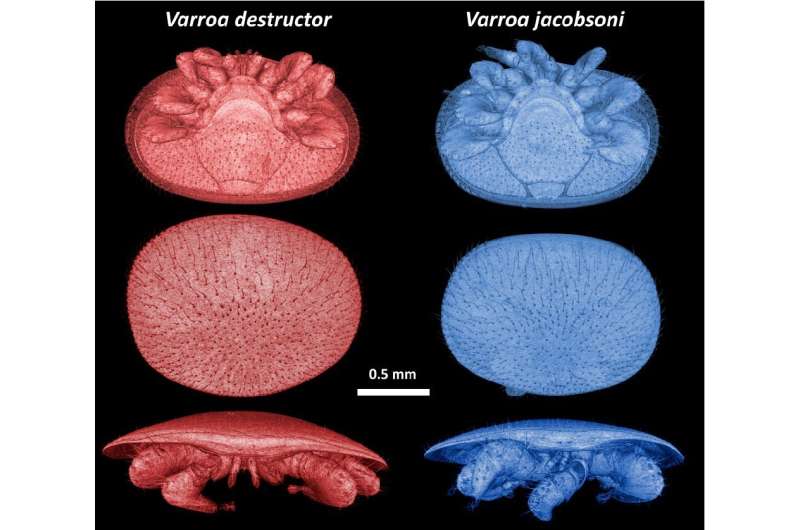Confronting colony collapse

Honey bee colony collapse has devastating consequences for the environment, the global economy, and food security worldwide. The culprits behind some of the destruction—parasitic Varroa mites—are just a couple of millimeters in size, and they infiltrate colonies and infect bees with viruses. Yet surprisingly little is known about the mite's biology.
Researchers from the Ecology and Evolution Unit at the Okinawa Institute of Science and Technology Graduate University (OIST) sequenced the genomes of the two Varroa mite species that parasitize the honey bee. They found that each species of mite used its own distinct strategy to survive in its bee host, potentially overwhelming the bees' defenses. In addition to pointing to how scientists might vanquish these deadly intruders, the findings also shed light on how parasites and hosts evolve in response to one another.
The scientists' findings, published in Communications Biology, represent an international effort by scientists in the United States and Australia, underscoring the global nature of the issue.
"When you look outside, every species you see has managed to survive infestation by parasites or diseases. Many organisms haven't met the challenge and have gone extinct," said Professor Alexander Mikheyev, the last author of the study. "We want to understand the coevolutionary interactions between mites and bees to save the honey bee from such a fate."
The Evolution of a Parasite
Two distinct species of the Varroa mite parasitize domesticated honey bees. Originating in Asia, the mites originally targeted the eastern honey bee. As settlers transported bee colonies across the world throughout the 20th century, the mites spread to Europe, then to the Americas in the 1970s and 1980s, threatening western honey bee populations.
To better understand how the mites and bees co-evolved over time, Mikheyev, postdoctoral researcher Dr. Maeva Techer, and their collaborators sequenced the genomes of each of the two Varroa species, finding that they share 99.7% of their DNA and appear virtually indistinguishable.
Despite these similarities, genetic evidence indicated that the mite species followed separate evolutionary paths. These divergent strategies of adaptation may make it more difficult for the host species to develop a tolerance to multiple parasites at once.
"The implication is that if you're trying to fight parasites, the methods that might work for one might not work for another due to differing mechanisms for adapting to the host," said Mikheyev.
Mikheyev and Techer hope the sequenced genomes can help lay the foundation for species-specific interventions to address colony collapse, while also furthering scientific understanding of parasite evolution and adaptation.
"It's important to consider that parasites are constantly evolving, and, in many ways, they have a greater potential to evolve than honeybees because they reproduce quickly," Mikheyev said. "As we're trying to fight these parasites, we have to remember that our target is always moving."
More information: Maeva A. Techer et al. Divergent selection following speciation in two ectoparasitic honey bee mites, Communications Biology (2019). DOI: 10.1101/512988
Journal information: Communications Biology
Provided by Okinawa Institute of Science and Technology



















